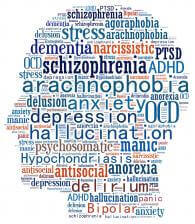5 Therapy Myths and Fears Busted
While millions of people are comfortable seeking help from a psychologist, psychiatrist, or other counselor, others–maybe you included–would rather pass a kidney stone than make an appointment with a therapist. This week, the Savvy Psychologist helps you (or someone you love) get over 5 common myths and fears about therapy.
Seeking help from a psychologist, psychiatrist, or other counselor can be a great way to get through a rough patch, get some perspective, or optimize your life. But not everyone feels comfortable taking that step.
This week, we’ll address some common myths and fears that may needlessly be keeping you from getting help and feeling better. Next week, we’ll cover how to talk to someone in your life who could use a psychological tune-up, but needs a gentle nudge (or even a compassionate kick in the head) to make that first appointment.

Likewise, a 2009 study of over 36,000 people found that in the past year, fully 4% had thought seriously about suicide or had attempted suicide. Of that 4%, half of those who had contemplated suicide and one-quarter of those who had attempted suicide didn’t seek help, or even perceive the need for help.
The take home: there are millions of people out there, perhaps even you or someone you love, who could benefit from a few sessions with a good psychologist, psychiatrist, or other counselor. But it takes strength to seek help, and know-how to get in the door. To that end, here are 5 common barriers to seeking treatment–and how you can convince yourself (or someone you love) to overcome them.
Want more tips? Check out How to Ask for Help
Barrier #1: I Can Fix This Myself
In an independent, self-reliant culture like ours, seeking help is often equated with weakness. In truth, getting help is a sign of strength and courage. There’s no shame in taking your car to a mechanic, your money to a financial adviser, or your golf swing to a coach. You wouldn’t treat a broken leg on your own, right? The same should be true for depression, addiction, or any other affliction that’s sucking the life out of you.

Therefore, if you’re dealing with a macho man who could use a mental health tune-up, link the idea of going to therapy to his existing beliefs about individual peak performance. For instance, “A few sessions with a good coach would bring you back to your old unstoppable self,” or “Just like you saw your financial planner to strategize about taxes, let’s consult with a psychologist about staying sharp/feeling awesome/focusing better/getting that extra edge.”
Last ditch: if Tony Soprano and Metallica can go to therapy, you can, too.
Barrier #2: It’s Too Expensive
This is a big one. Consider these 5 options to get you through the door without breaking the bank:
- If you have health insurance, you might be covered for psychotherapy and/or substance abuse treatment. Most health insurance plans, including Medicaid managed care plans, are required to follow the federal parity law and provide mental health coverage. Call your insurance company and ask what your behavioral health coverage includes. While you’re at it, ask them for a list of psychologists in your area who take your plan.
- See if your employer has an Employee Assistance Program, or EAP, available as part of your benefits. In general, EAPs offer short-term counseling for employees and immediate family, including help with drug or alcohol abuse, emotional distress (like depression or anxiety), stress management, debt counseling, non-work-related legal issues, and more. They’re pre-paid by your employer, which makes services free to you, and they’re confidential—information about your use of an EAP cannot be disclosed without permission from you.
- To go the private practice route, search online for “sliding scale psychotherapy” or “sliding scale psychologist” to find practitioners who charge based on your income rather than a set fee.
- Search out a clinic run by a psychology graduate training program. Most student clinics charge low or sliding scale fees and are staffed by Ph.D., Psy.D., or Master’s students. All students are supervised by licensed professionals, so you’re actually getting a two-for-one deal. Look on the psychology department website of universities in your area, or try searching online for “school of professional psychology.”
- Dial 211 or search for “211” online. 211 connects you to human services in your area that may include drug and alcohol services, food and shelter referrals, elder services, and more.
Barrier #3: But I’m Not Crazy!

If perceived stigma is standing between a loved one and treatment, you may wish to frame therapy as lessons, coaching, consultation, or skills training. Indeed, most therapists worth their salt treat therapy like a one-on-one class, complete with homework. Lying on couches is a thing of the past, and no one wearing tie-dye and smelling of patchouli will clasp your hand and ask, “How does that make you feel?” More likely, a friendly professional will ask questions about symptoms, help you challenge ineffective ways of thinking and acting, and teach you some new skills. No incense or straightjackets necessary.
Barrier #4: I Don’t Want to End up in a Psych Ward
If you have enough presence of mind to worry about this, then rest assured–you’ll be fine.
In California, where I practice, you can only be hospitalized involuntarily for three reasons: 1) you are an immediate danger to yourself, meaning you plan to commit suicide–or you are convinced, for example, that the FBI has planted a chip in your brain and you are trying to get it out with a knife; 2) you plan to kill a specific, identified person (NOT just, “I’m so mad, I could kill someone!”); and 3) you’re gravely disabled, which means you cannot feed, house, or clothe yourself because of a mental illness (as in, “Aliens have poisoned our water supply, so I’m not going to eat or drink ever again.”)
If one of these things is true, you can be taken to a hospital for a 72-hour hold to make sure you and everyone else stays safe. Roughly half of the states have laws similar to California, where commitment is based on the level of danger; the remaining half have laws based on a need for treatment, but the bar is high and requires severe and persistent mental illness, usually with an inability to live safely and independently.
Again, if your mind works well enough to ponder whether this means you, it probably doesn’t. But if you’re still worried, search online for your state and the phrase “civil commitment.”
The most likely option for most individuals contemplating therapy is seeing an outpatient provider. This is light years away from a psych ward. Let me put it this way: if an involuntary hospital stay is the Hummer H2 of mental health care, then the traditional outpatient, hour-per-week therapy session is a Smart car. It will get you where you want to go, it’s totally effective and safe, but it’s a lot less intimidating.
Barrier #5: I Had a Bad Experience with Therapy in the Past
Yes, not every lid goes with every pot. And unfortunately, there are lots of lousy therapists out there. Therapists are people, and like all people, they have foibles and varying levels of competence. But one session from hell shouldn’t keep you from finding a match made in heaven.
Get a recommendation from a friend, or look at reviews online. Cross-reference the list of psychologists from your insurance with therapists’ websites and choose someone with a philosophy that seems to fit you. Don’t be afraid to shop around. Try on therapists as you would try on a new suit or test-drive a new car.

Next week, we’ll cover 5 tips on how to talk to someone you think could benefit from giving therapy a try.
Please note that all content here is strictly for informational purposes only. This content does not substitute any medical advice, and does not replace any medical judgment or reasoning by your own personal health provider. Please always seek a licensed physician in your area regarding all health related questions and issues.
REFERENCES:
Messias, E., Eaton, W., Nestadt, G., Bienvenu, O.J., & Samuels, J. (2007). Psychiatrists’ ascertained treatment needs for mental disorders in a population-based sample. Psychiatry Services, 58, 373-7.
Pagura, J., Fotti, S., Katz, L.Y., Sareen, J., & Swampy Cree Suicide Prevention Team. (2009). Help seeking and perceived need for mental health care among individuals in Canada with suicidal behaviors. Psychiatric Services, 60, 943-9.
Springer, K.W. & Mouzon, D.M. (2011). “Macho men” and preventative health care: implications for older men in different social classes. Journal of Health and Social Behavior, 52, 212-27.
Therapy Images courtesy of Shutterstock.com



